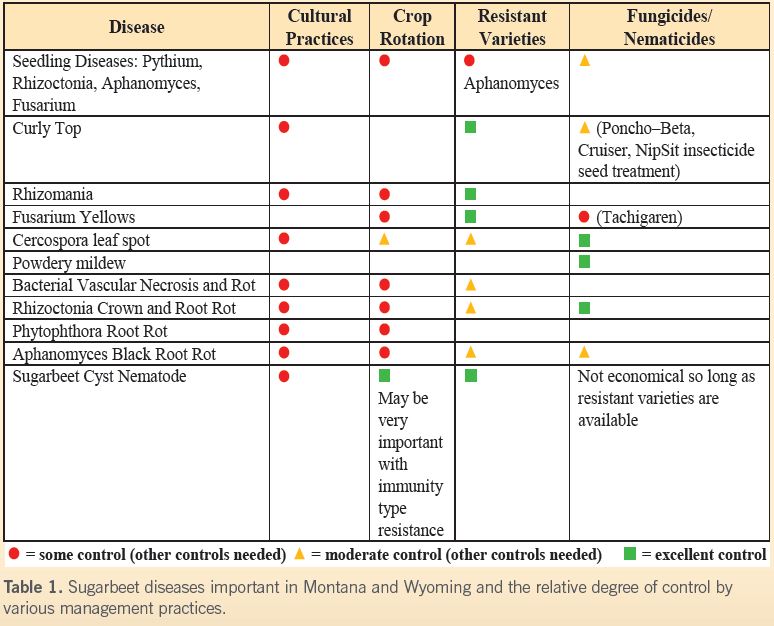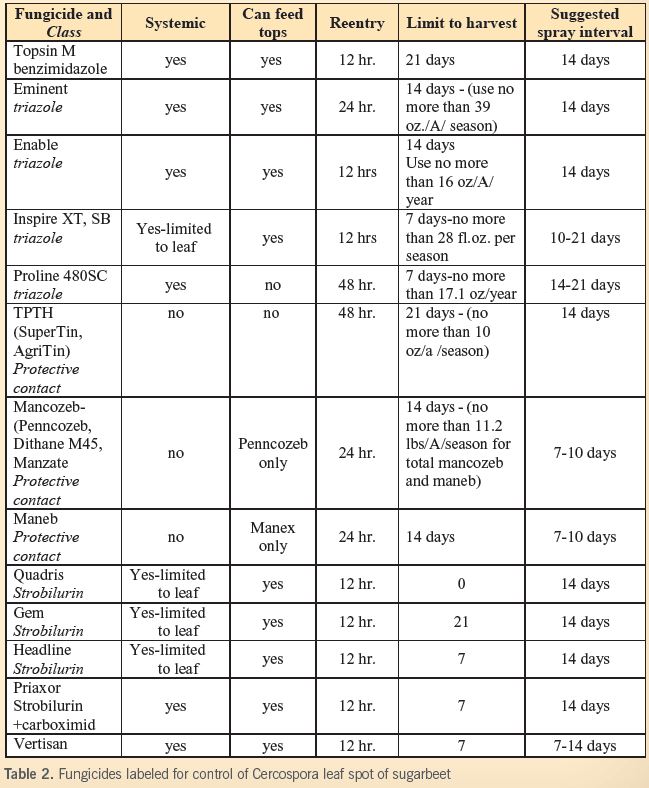Sugarbeet diseases annually reduce profitability by an estimated 10-15 percent, with losses in individual fields exceeding 50 percent or more.
Losses occur in the production field, storage piles and during processing. Successful management requires integration of several management strategies by producers. These include planting high-quality seed, appropriate cultural practices, use of seed treatment fungicides, selection of disease-resistant varieties, crop rotation, disease monitoring/scouting, fungicides, nematicides and delivering high-quality, disease-free beets to the storage pile.
Much of the recent yield increases can be attributed to reducing losses from Rhizomania, cyst nematode, curly top virus, Fusarium yellows, Rhizoctonia crown and root rot and Apahnomyces black root rot. Diseases of importance to Montana and Wyoming growers and available control strategies are detailed in Table 1.
Stand establishment
Achieving adequate stand establishment is one of the most critical factors in obtaining high yields of sugarbeets with high sugar and low sugar loss to molasses (SLM).
Typically, stand establishment is only 60-75 percent of the seed sown. Thin stands are a major factor in weed problems and skips created by beets lost to damping-off are the major sites for late emerging weeds. Large beets that grow adjacent to skips will have lower sugars and higher SLM.
Seedling pathogens including Pythium, Fusarium, Rhizoctonia and Aphanomyces are among the most important factors in reducing stands. These pathogens can cause seed rots, pre-emergence and post-emergence damping-off. Several factors including soil moisture, soil temperature and seed vigor influence these pathogens. In general, these pathogens will cause more extensive damage whenever seedling emergence is slowed by cold soils, too wet or too dry conditions in the seedbed, planting too deep, ammonia or salt toxicity or where seed vigor is low.
Early planting is often correlated with higher yields but frequently enhances these negative factors. Low seed vigor can be due to low or weak germination potential of a given seed lot, seedborne pathogens such as Phoma betae or due to the genetics of the variety. While seed germination is easy to determine, seed vigor determination is very difficult. Virtually all commercial seed will have high germination (90 percent or above), but when seedling emergence is slowed by a number of factors, seedling establishment may be less than 70 percent.
Sugarbeet seed requires the absorption of 50 percent of the seed weight in moisture before germination will occur and adequate moisture must be present through the germination and seedling establishment period. Soil temperatures need to be 45-50 degrees or above during this period. Seed treatment fungicides typically applied to all seed will protect the seed or seedling from these pathogens for 1-2 weeks when conditions are unfavorable for germination and products such as metaxyl (Apron, Allegience, Acquire and Sebring) or Tachigaren will provide protection from post-emergence damping-off by Pythium for an additional 1-2 weeks and Tachigaren for Aphanomyces for a similar period.
Use of Tachigaren seed treatment particularly above 20g/seed unit can slow germination particularly on some genotypes. The 20-gram rate has been adequate for most situations in Montana. A new seed treatment fungicide, Dynasty (azoxystrobin), has been labeled and our data from the past five years has shown that we can achieve significant stand and yield increases from control of Rhizoctonia damping-off.
However, another new fungicide-penthiopyrad-will be labeled next year. Research here and elsewhere indicates that this fungicide is superior to Dynasty. Data indicates that both Dynasty and penthiopyrad are compatible with all seed treatment fungicides registered on sugarbeet and with Poncho-Beta, Nipsit Inside and Cruiser insecticide seed treatments.
The Nipsit Suite seed treatment has Nipsit Inside insecticide and the fungicides Metlock and Sebring. Metlock (metconazole) has good activity against Fusarium and Rhizoctonia damping-off and Sebring (metalaxyl) will provide protection from Pythium damping-off.
Growers should plant into well prepared seedbeds that will assure good seed-soil contact that have soil temperatures greater than 45-50 degrees at the 2-inch depth and adequate moisture to support both germination and seedling establishment. Fall irrigation can assure good soil moisture availability for seed germination in the spring. Varieties known to have poorer seed vigor characteristics should be planted under the most favorable conditions.
Crop rotation
Crop rotations are powerful controls for cyst nematode and Cercospora leaf spot and rotations of 2-4 years will help reduce the incidence and severity of diseases, such as Rhizoctonia crown and root rot and Fusarium yellows.
Crop rotations allow for increased impact of natural biological controls and will markedly reduce inoculum potential for sugarbeet cyst nematode and Cercospora leaf spot. Hosts for the sugarbeet cyst nematode include canola and common weeds, including mustard, pigweed, lambsquarter and shepherds purse. Hosts for Cercospora beticola, the causal agent of Cercospora Leaf Spot, include safflower and weeds such as pigweed, lambsquarter, mallow and wild buckwheat. Therefore, weed control is important in rotation crops.
For pathogens such as Rhizoctonia and Fusarium, rotations of greater than two years will reduce the build up of these pathogens.
Resistant varieties
Adapted and approved varieties are available that are resistant or tolerant to Cercospora leaf spot, Rhizoctonia crown and root rot, Fusarium yellows, curly top virus, Rhizomania virus, Aphanomyces black root rot, sugarbeet cyst nematode and bacterial vascular necrosis.
The use of Poncho Beta seed treatment, Nipsit Inside and Cruiser will provide excellent protection against curly top infection on approved varieties with moderate levels of resistance, particularly when planted late or in a replant situation. These insecticide seed treatments will not provide control on curly top-susceptible varieties.
The only practical control for fields infested with Rhizomania is the use of resistant variet-
ies. When Rhizomania-resistant varieties were first introduced to Montana and Wyoming markets, these varieties often had lower levels of curly top and Fusarium yellows resistance. This is no longer the case.
At the present time, Montana and Wyoming Rhizomania varieties have resistance from the "Holly gene." In California and Idaho, where varieties with this type of resistance have been planted three to four times, resistant breaking strains of the Rhizomania virus have caused damage and in 2010 strains that can attack the "Holly gene" were found in Montana and Wyoming. For this reason, growers, consultants and fieldmen should identify where resistant varieties have failed and determine which strains of Rhizomania are present.
Strains of Rhizomania that can damage beets with the "Holly gene" appear to have a very wide distribution in Montana and Wyoming at this time. Rhizomania is spread with infested soil. Avoid putting any tare dirt back on fields that will be used for beet production.
Disease monitoring
The temperature/humidity monitoring for Cercospora leaf spot prediction has paid major dividends for growers and processors in Montana the past 16 years. It assures spray programs start at the right time and avoid applications when infection potential is low or non-existent.
During this time, the use of the weather-based Minnesota Cercospora prediction program saved growers in the Sidney factory district an average of one to two fungicide applications. Growers were saved two or more applications in the Billings factory district.
Research over the past 12 years demonstrates that fungicide (Quadris, Proline) applications for Rhizoctonia Crown and Root Rot Control should occur when soil temperatures at the 2-4 inch level (average of high and low for the day) is 60-70 degrees. Research has also shown that applications at the 4-8 true leaf growth stage have given good control; however, application at only the 4-leaf or the 8-leaf stage have given optimal results in only some years. The reason of the inconsistency is that the Rhizoctonia fungus does not cause infections until temperatures exceed 70-75 degrees.
Fungicide programs
Several fungicides are labeled for use on sugarbeets (see Table 2) and their selection depends on whether the beet tops are to be fed and prior fungicide use.
Spray intervals should be carefully observed since new growth will need to be protected, and fungicides do break down. Typically a new ring of leaves are developed each week during July and August and protection of these leaves is critical to achieving high yields, high sugars and good storage and processing characteristics. Sprays should start at disease onset and be repeated at recommended intervals.
Generally no more than 1-4 sprays are required in Montana because cool night temperatures generally slow disease development sufficiently by September. However, with the warmer Septembers of recent years an additional application could be justified in early September.
Resistance by the Cercospora fungus to fungicides is a serious matter. To combat fungicide resistance fungicides of the same class (mode of action) should not be used sequentially.
Storage losses
Placing beets with damage from Rhizoctonia crown and root rot, Fusarium yellows, Bacterial Vascular Necrosis, Rhizomania or Aphnaomyces black root rot in storage piles will result in increased storage losses. Storage losses include direct loss in weight due to higher respiration rates, increased SLM and losses due to formation acids and reducing sugars that directly reduce white sugar output at the factory. Beets with significant damage from any of these diseases should be scheduled for early harvest and processed as soon as possible. Storage losses can also occur due to fungi.
Management of storage losses starts with selection of varieties with resistance to the diseases mentioned above. Next fields with damage from these diseases should be scheduled for early harvest and processed as soon as possible.
Control of storage molds and improved storage quality has been a focus of my research for the past four years. Our work has shown that you cannot store beets long term at temperatures greater than 50 degrees and that the cooler the beets are stored (down to freezing) the less damage from storage fungi and the lower the respiration sugar losses

 .
.